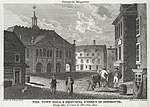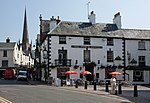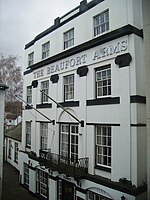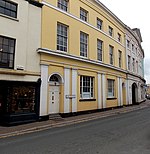Kings Head Hotel, Monmouth

The King's Head Hotel is a hotel standing opposite the Shire Hall in Glyndŵr Street, Agincourt Square, Monmouth, Wales. It dates from the mid-17th century, and as one of the major inns in Monmouth was reputedly visited by Charles I of England in 1645. It has a fine black-and-white painted stone façade and became an important posting inn in the late 17th century, with a yard through an archway where visitors' horses could be stabled and where regular coach services called. In the 18th and 19th centuries, stagecoaches for London left from the inn. The range of buildings along Agincourt Street now includes the former Monmouth Bank and the County Club, while the inn itself is now part of the J D Wetherspoon pub chain. It is one of 24 buildings on the town's Heritage Trail and is a Grade II* listed building.
Excerpt from the Wikipedia article Kings Head Hotel, Monmouth (License: CC BY-SA 3.0, Authors, Images).Kings Head Hotel, Monmouth
Agincourt Square,
Geographical coordinates (GPS) Address External links Nearby Places Show on map
Geographical coordinates (GPS)
| Latitude | Longitude |
|---|---|
| N 51.81179 ° | E -2.71575 ° |
Address
Agincourt Square 8
NP25 3DY , Overmonnow
Wales, United Kingdom
Open on Google Maps










